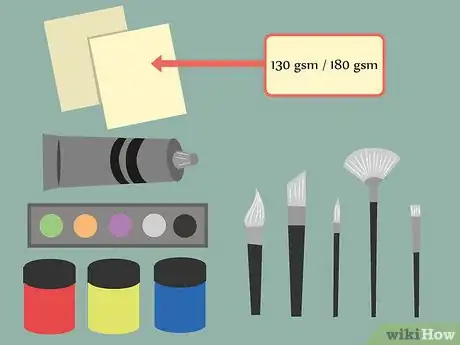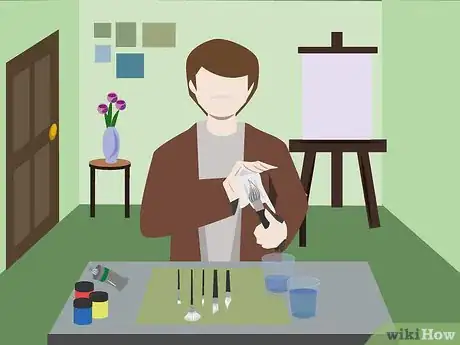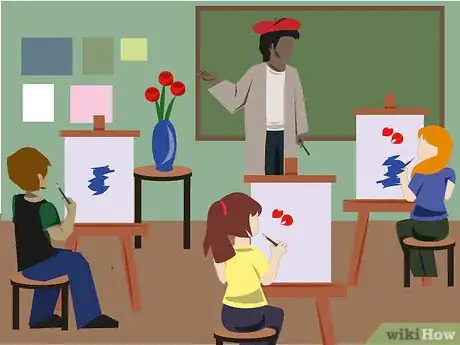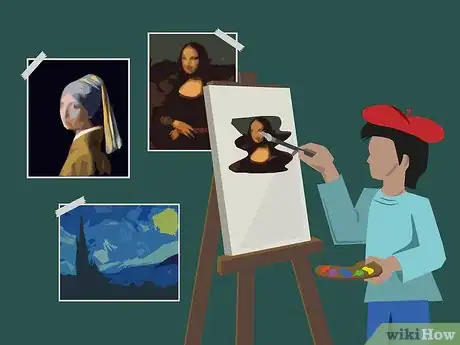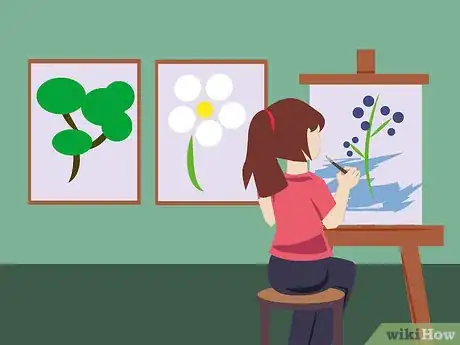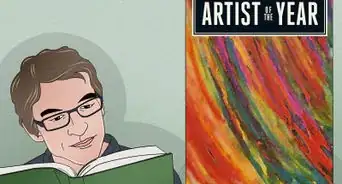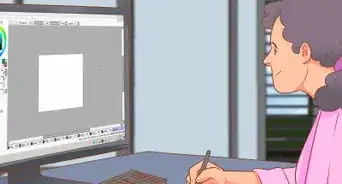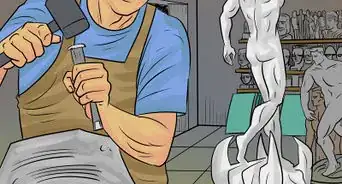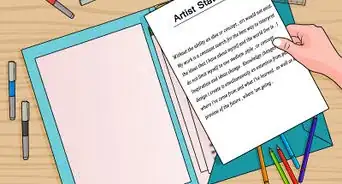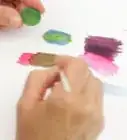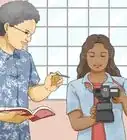This article was co-authored by Jeanine Hattas Wilson. Jeanine Hattas Wilson is a Professional Painter and the President of Hattas Public Murals, Inc. With nearly 20 years of experience, Jeanine specializes in creating, overseeing, designing, and painting murals. Jeanine holds a BA in Advertising from Marquette University and a Studio Painting Minor from The Milwaukee Institute of Art & Design. She has studied at The Atelier Artien in Paris, France, Los Angeles Academy of Figurative Art, and under renowned artists such as Robert Liberace, Michael Siegel, and William Cochran. To date, Hattas Public Murals has painted nearly 5,000 commissioned works of art in homes and commercial and public spaces.
There are 15 references cited in this article, which can be found at the bottom of the page.
This article has been viewed 58,574 times.
If every waking moment you're itching to pick up a brush and take pigment to canvas, a career as a professional painter and fine artist might be right up your alley. But the path to becoming a painting pro is rarely simple, and often involves dedicated study, constant exercise, and self-marketing. On top of being visually appealing to your public, you also need to know how to sell the work you have produced. No matter if you don't know where or how to begin, with some effort on your part and the development of some techniques, you'll stand a fighting chance of establishing yourself as a painter.
Steps
Educating Yourself in Your Medium
-
1Contemplate the kind of painter you want to become. There are many different kinds of painting styles and mediums. Three of the most popular mediums include oil, acrylic, and watercolor painting. Each of these mediums has a different effect on the canvas and conveys a different kind of atmosphere.[1]
- Spend some time at your local museum observing these styles. Inquire with museum staff about the method and training that artists you particularly enjoy used.
- Explore different kinds of painting through art lessons at a community center or school for fine art.
-
2Stock yourself with painting supplies. Since you'll be painting all the time as a career painter, you should purchase high quality supplies. These will ensure that you are able to produce the best possible work you can. General supplies you'll want to have on hand include:Advertisement
-
3Learn to maintain your equipment. It's no secret that art supplies can be expensive. Learning to upkeep your brushes and preserve your paints while learning your medium will make your life easier. You can find compounds designed to remove artistic substances, like acrylic or oil paints, at most specialty art stores.[5] Familiarize yourself with:
- Removing acrylic paint from brushes
- Removing oil paints from your brushes
- Maintaining your palette
- Refreshing your paintbrushes
-
4Invest time learning each medium. Even if you consider yourself to be a mostly acrylic painter, you never know when you'll need to use a certain medium, like watercolor, for effect or to fill an order from a client. Additionally, you may find out you enjoy a certain style more than you initially thought.[6]
- Try painting a variety of objects. You might discover that you like watercolors best for landscape painting and oil paints more for portraits.
-
5Study art theory. You may consider your style to be of the utmost importance, but in the words of the Dalai Lama, you should "Know the rules well, so you can break them effectively."[7] Color theory will help cultivate your intuition of how different colors work together and the emotions these evoke. Studies in shading will provide you with a better understanding of how to bring out depth in your paintings, and so on. [8]
- There are many different approaches to art theory, and the broadest education you receive on the topic might come from an art theory class at a university, community college, or community center.
- Some techniques work well across many mediums, some techniques only apply to a single medium. Art theory can help you determine which technique will help you achieve your goal best.
-
6Find a studio where you can practice. The kind of location you choose for a studio might be limited by many factors, like income and availability, to name a couple. You might also find that your taste in studio changes over time. For example, you may find yourself most productive working in a studio in a lively part of town in your youth, only to prefer a more remote and quiet location later in your life.
- Windows that allow natural light can be an asset to your work as a painter. You can always put up a sheet or curtains to block out excess light in the event you need a dimmer ambiance to work.
- Be sure your room is adequately ventilated. Some paints, like many that are oil based, give off fumes that can be dangerous in enclosed spaces.
Training Yourself as a Painter
-
1Consider a school for fine artists. School can be both a place to receive an education and a place to receive training. Some programs focus on imparting knowledge to students, while others focus on the application of skills. Many fine art programs offer broad exposure to many different kinds of fine art, which help you create richer art. Some areas you might be trained in:
- Painting
- Drawing
- Printmaking
- Sculpture
-
2Imitate the masters. Even if you were born with a gift as a painter, your skill can always be sharpened. Experts agree, by duplicating a difficult piece by a master, you can train your skills as an artist and gain insight into the process of the master you are studying.[9] Some of your imitation work might even be chosen by organizations, like the Royal Society of Portrait Painters, for an exhibition.[10]
- Some classes may stress a certain aesthetic, like cartooning or portraiture, and can improve your problem areas rapidly.
- You may benefit from doing a masterwork study every month. Choose one painting per month from a master you admire and try to imitate it.
-
3Discover your theme. Most, if not all, professional artists find themselves drawn to a particular concept or subject. This can be as simple and definite as "octagons," or as complex and nuanced as "the divine expressed in man." Look through your art and honestly search yourself to find what resonates with you. This is your theme, and should be developed.
-
4Keep inspiration flowing. Every artist has a different approach to their artistic process. You'll have to spend some time trying different things and soul-searching to find how to consistently motivate yourself. Some ideas to consider:
- Go for a nature walk and draw inspiration from the natural world.
- Search the web for photos that resonate with you.
- Search for artists in the same school or time period as artists you admire.
- Visit an at museum. Bring along a sketchbook and jot some ideas down to develop later.
-
5Paint constantly. Artistic jobs are sometimes looked at as being subject to the whims of creativity. But just like an accountant must crunch numbers every day to earn his salary, so too must you pick up your paintbrush and soldier through the uninspired times of your career to preserve and improve your skill.
-
6Apprentice yourself to a professional artist. Unfortunately, apprenticeship has fallen out of popularity in many parts of the world, but this is a small obstacle you can overcome. Visit local artists and choose one that you connect with both personally and artistically. Then:
- Trade your time or effort (cleaning, stretching canvas, etc.) for use of the artist's studio and her direction.
- Volunteer your time assisting the artist. She might not be able to afford to pay you, but while volunteering, you'll get an insider's look at her process and business model.[13]
Marketing Your Art for Profit
-
1Think of a profitable activity. This does not have to be the final goal of your art career, but should instead be something to keep you artistically engaged while paying the bills. For many painters, this translates to portraiture. Sign up to do 15 minute portraits at a local fair or outdoor event. You might also:[14]
- Paint local or iconic scenes and print these on postcards. You could sell these online, or to a local boutique.
- Bid to paint public art installations, like murals.
- Sell pieces to a local gallery.
-
2Make, and keep, connections. While you are going to school or during your apprenticeship, you'll meet other artists, art collectors or buyers, and other people associated with fine art. Make up some simple business cards with your information and exchange these with people who might be able to help you in your goal of becoming a painter.[15]
-
3Brainstorm venues for selling. Once you figured out the theme you are passionate about and the medium you prefer working in, devote time and thought to the people who will buy your art. You'll need to do some research, as every situation will be different for each artist, but you might look into:
- The people who have bought your art in the past. What features do these people have in common, and how might you use that information to sell your art?
- Artists similar to yourself. Look at the business model of these people, who they are marketing to, and how they are marketing.
-
4Start a website. There are also hosted sites you might go through, like Etsy and Patreon, but having your own website can accomplish two purposes for you. First and foremost, you can include your portfolio and post pieces that are for sale as well as a shopping cart feature for those who would like to buy your art outright. Secondly, your business website will give you more of a presence as an artist, making you look more professional to prospective clients.[16]
-
5Open a gallery. It might be a while before you can afford to open your own gallery to sell your work, but you might be able to snag an exhibition at a gallery that focuses on new and emerging talent. These venues are frequently found in urban and semi-urban environments. Submit your art for review with the gallery manager.[17]
- Schools can sometimes be a profitable place for you to start, or in some cases offer cheaper spaces for exhibiting the work of beginning artists.
-
6Treat your work like a business. Though many artists create work as a labor of love, you should still treat your work as a business. It is, after all, the thing you hope to make a living off of.[18] Don't offer freebies unless for a reason, like for marketing purposes.[19]
- Though people might think, "it's easy for her to paint," those people don't realize how much time, effort, and money you've spent developing that skill.
- Always treat your time and skill as a resource and make it clear you expect appropriate compensation for your efforts.
Expert Q&A
-
QuestionIs it possible to make a living as a painter?
 Jeanine Hattas WilsonJeanine Hattas Wilson is a Professional Painter and the President of Hattas Public Murals, Inc. With nearly 20 years of experience, Jeanine specializes in creating, overseeing, designing, and painting murals. Jeanine holds a BA in Advertising from Marquette University and a Studio Painting Minor from The Milwaukee Institute of Art & Design. She has studied at The Atelier Artien in Paris, France, Los Angeles Academy of Figurative Art, and under renowned artists such as Robert Liberace, Michael Siegel, and William Cochran. To date, Hattas Public Murals has painted nearly 5,000 commissioned works of art in homes and commercial and public spaces.
Jeanine Hattas WilsonJeanine Hattas Wilson is a Professional Painter and the President of Hattas Public Murals, Inc. With nearly 20 years of experience, Jeanine specializes in creating, overseeing, designing, and painting murals. Jeanine holds a BA in Advertising from Marquette University and a Studio Painting Minor from The Milwaukee Institute of Art & Design. She has studied at The Atelier Artien in Paris, France, Los Angeles Academy of Figurative Art, and under renowned artists such as Robert Liberace, Michael Siegel, and William Cochran. To date, Hattas Public Murals has painted nearly 5,000 commissioned works of art in homes and commercial and public spaces.
Professional Painter Yes, but you have to have a good understanding of how business works. As an artist, you're basically just a self-employed entrepreneur.
Yes, but you have to have a good understanding of how business works. As an artist, you're basically just a self-employed entrepreneur. -
QuestionWhat should I study to become an artist?
 Jeanine Hattas WilsonJeanine Hattas Wilson is a Professional Painter and the President of Hattas Public Murals, Inc. With nearly 20 years of experience, Jeanine specializes in creating, overseeing, designing, and painting murals. Jeanine holds a BA in Advertising from Marquette University and a Studio Painting Minor from The Milwaukee Institute of Art & Design. She has studied at The Atelier Artien in Paris, France, Los Angeles Academy of Figurative Art, and under renowned artists such as Robert Liberace, Michael Siegel, and William Cochran. To date, Hattas Public Murals has painted nearly 5,000 commissioned works of art in homes and commercial and public spaces.
Jeanine Hattas WilsonJeanine Hattas Wilson is a Professional Painter and the President of Hattas Public Murals, Inc. With nearly 20 years of experience, Jeanine specializes in creating, overseeing, designing, and painting murals. Jeanine holds a BA in Advertising from Marquette University and a Studio Painting Minor from The Milwaukee Institute of Art & Design. She has studied at The Atelier Artien in Paris, France, Los Angeles Academy of Figurative Art, and under renowned artists such as Robert Liberace, Michael Siegel, and William Cochran. To date, Hattas Public Murals has painted nearly 5,000 commissioned works of art in homes and commercial and public spaces.
Professional Painter Take business classes in addition to art classes. If you haven't enrolled yet, look for an art school that's connected to a university that has business education classes. For instance, you might major in art and then minor in business.
Take business classes in addition to art classes. If you haven't enrolled yet, look for an art school that's connected to a university that has business education classes. For instance, you might major in art and then minor in business. -
QuestionIs talent all that you need to become an artist?
 Jeanine Hattas WilsonJeanine Hattas Wilson is a Professional Painter and the President of Hattas Public Murals, Inc. With nearly 20 years of experience, Jeanine specializes in creating, overseeing, designing, and painting murals. Jeanine holds a BA in Advertising from Marquette University and a Studio Painting Minor from The Milwaukee Institute of Art & Design. She has studied at The Atelier Artien in Paris, France, Los Angeles Academy of Figurative Art, and under renowned artists such as Robert Liberace, Michael Siegel, and William Cochran. To date, Hattas Public Murals has painted nearly 5,000 commissioned works of art in homes and commercial and public spaces.
Jeanine Hattas WilsonJeanine Hattas Wilson is a Professional Painter and the President of Hattas Public Murals, Inc. With nearly 20 years of experience, Jeanine specializes in creating, overseeing, designing, and painting murals. Jeanine holds a BA in Advertising from Marquette University and a Studio Painting Minor from The Milwaukee Institute of Art & Design. She has studied at The Atelier Artien in Paris, France, Los Angeles Academy of Figurative Art, and under renowned artists such as Robert Liberace, Michael Siegel, and William Cochran. To date, Hattas Public Murals has painted nearly 5,000 commissioned works of art in homes and commercial and public spaces.
Professional Painter Talent is important, but having a strong business sense is also very valuable. You can be the most talented artist in the world, but if you don't know business, no clients will be able to find you.
Talent is important, but having a strong business sense is also very valuable. You can be the most talented artist in the world, but if you don't know business, no clients will be able to find you.
Warnings
- Some acrylic paints and other kinds of paint are poisonous. Be sure you read the labels of all supplies before using and are working in a well ventilated space.[20]⧼thumbs_response⧽
References
- ↑ http://www.kidzworld.com/article/23736-the-different-types-of-paint
- ↑ http://www.art-is-fun.com/acrylic-painting-supplies/
- ↑ http://www.craftsy.com/blog/2015/05/oil-painting-supplies/
- ↑ http://www.studentartguide.com/resources/best-paper-for-drawing-painting-students
- ↑ Jeanine Hattas Wilson. Professional Painter. Expert Interview. 11 May 2021.
- ↑ http://www.essentialvermeer.com/technique/technique_overview.html#.Vqk1TPkrLIU
- ↑ http://www.goodreads.com/quotes/16419-know-the-rules-well-so-you-can-break-them-effectively
- ↑ http://www.colormatters.com/color-and-design/basic-color-theory
- ↑ http://www.pikaland.com/2013/07/02/copying-other-peoples-art-technique-or-style-youre-copying-the-wrong-thing/
- ↑ http://willkempartschool.com/the-3-steps-to-becoming-a-better-painter-by-painting-less/
- ↑ http://www.klimtgallery.org/biography.html
- ↑ http://www.alfonsmucha.org/biography.html
- ↑ http://www.theguardian.com/money/2015/may/19/how-become-tattoo-artist-phil-kyle
- ↑ Jeanine Hattas Wilson. Professional Painter. Expert Interview. 11 May 2021.
- ↑ http://www.businessinsider.com/8-ways-an-artist-can-make-money-2013-11
- ↑ Jeanine Hattas Wilson. Professional Painter. Expert Interview. 11 May 2021.
- ↑ http://www.businessinsider.com/8-ways-an-artist-can-make-money-2013-11
- ↑ Jeanine Hattas Wilson. Professional Painter. Expert Interview. 11 May 2021.
- ↑ http://www.businessinsider.com/8-ways-an-artist-can-make-money-2013-11
- ↑ http://www.art-is-fun.com/toxicity-of-acrylic-paint/
About This Article
To be a painter, start by taking art classes at a local community college so you can learn about different kinds of painting styles and mediums, such as oil, acrylic, and watercolor painting. Then, find a studio or create one in a well-ventilated room at home and paint every day, since a skill can only be improved through practice. Additionally, consider enrolling in a school for fine arts to improve your technique and further your artistic knowledge. You should also look for work as an apprentice to a professional artist to prepare for your own career in the field. For tips on how to make money from your paintings, keep reading!

